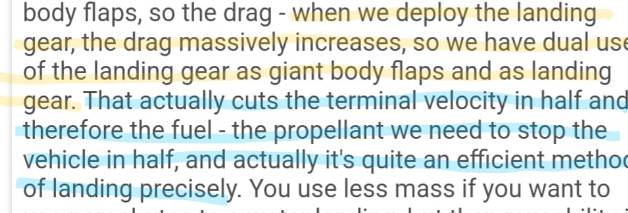Is this garbage supposed to be a real source?
A Website titled: S*** Elon Says ?
From the wayback machine?
Kind of a stretch when you can simply go to Space X site or any study about the Falcon 9. Was this what you spent all day looking for? This garbage interview?
This is just crap a billionaire lol says. He says really idiotic things daily…
Wait… Do you actually think Elon Musk is a scientist & inventor?? You think he has any clue about space flight? Let me guess you think he invented the electric car? LMFAO
What does this garbage have to do with grid fins?
Any projected area, surface & mass can reduce terminal velocity lol.
Yes, you increase the surfaces area of a falling object through a gas or liquid it will reduce its terminal velocity. This means nothing LMFAOOO
ANY surface can be used to reduce terminal velocity. Even LANDING GEARS. That is why it was mentioned. Do you even know what terminal velocity is??? lol
Jesus Christ, you are brilliant.
The landing gear already works to provide drag, they get dual use out of the landing gear.
Not the Grid fins.
LMFAO. Even Elon confirms the landing gear provides drag. Not the Grid Fins. The grid fins control the Falcon 9’s attitude roll, yaw & pitch.
Your 4th grade reading comprehension full display once again.
You even highlighted the proof that your whole idea that grid fins are used as airbrakes is completely made up.

Dude omg this hilarious! My boy, do you think before you post??
You invertedly highlighted the proof that I was right from the beginning…
Grid fins are not airbrakes, neither are they designed to produce more drag. They are hypersonic grid fins.
The Falcon 9 slows down with its reentry booster & massive drag of the landing gear. According to Elon Musk.
Thanks Elon!






